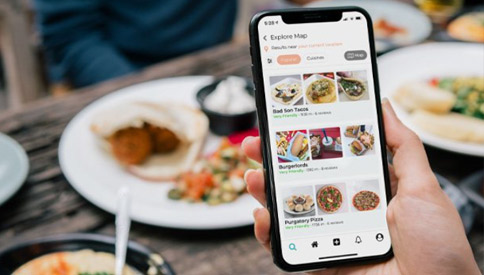What’s Next? Getting Ahead of 2022 Headwinds
By Jill Blanchard
Since the pandemic started, grocery manufacturers have contended with its devastating impact on nearly every front: Labor availability. Changing consumer habits. Supply chain constraints. Rising raw material costs.
Some have had their hands full putting out fires and building more capacity to meet sustained, increased demand for at-home food. Others, not many, have done this and considered the important question (though sometimes asked with hands thrown up in the air), “What’s next?!”
Anticipating “what’s next” and proactively preparing for what’s to come — or what may come — may be the deciding factor in who wins and who loses in the first half of 2022.
No one has a crystal ball, but some important questions grocery manufacturers should be asking themselves, their customers and their business and information and intelligence partners are: When will volume plateau? When will consumers start to push back on price increases? When will labor constraints ease? What do retailer partnerships look like moving forward? Which consumer habits are sticking or evolving?
But perhaps the most important question they can strategize around is, “What burgeoning issues have the potential to powerfully disrupt the first few months of 2022?”
Here are three to consider:
1. Transportation
In our March 2021 Advantage Sales survey of grocery manufacturers, 29% of respondents said they were “very concerned” about transportation. Just six months later, 93% of surveyed manufacturers told us transportation was a challenge.
In October, the American Trucking Associations’ Chief Economist Bob Costello said the current driver shortage has risen to 80,000 — an all-time high for the industry — and predicted that number will double by 2030 if the industry doesn’t act to make truck driving more attractive as a career option for younger people. “To keep up with demand over the next decade, trucking will need to recruit nearly 1 million new drivers in order to close the gap caused by demand for freight, projected retirements and other issues,” he said.
Interestingly, one grocery manufacturer expressed concern during the summer that trucks and drivers may be scarce as demand increases in the holiday season. The company’s leaders encouraged retailers to buy and have product delivered earlier than usual and, as a result, is experiencing less damage from the transportation-related supply chain challenges prevalent right now.
When it comes to supply chain and transportation hurdles, a few questions for manufacturers to consider include: How are they improving their visibility into retailers’ volume and expected volume? How much control do they have over their carriers? Should they implement bracket pricing to encourage the shipment of full trucks to retailers?
2. Price Sensitivity
As manufacturers increase prices to offset a rise in the cost of materials, labor and transportation — and contemplate taking even more than they planned just a few months ago — most of those price bumps are now being reflected at the shelf. Shoppers and media are taking notice.
In the past few months, the impact of rising prices on consumer demand has been negligible. But, with increased prices in everyday expenses, this won’t last. Consumer prices jumped more than 6% in October, pushed by surging gasoline prices and high inflation for food, according to a Supermarket News report citing the U.S. Bureau of Labor Statistics.
Food pricing was up 5.3% year over year in October, with a monthly gain of 0.9% — a repeat of September’s price hike. More dramatically, consumer data specialist Numerator found the average price per grocery item was up 7.1% in October 2021 vs. year-ago and up 11.6% vs. two years ago. When examined at a channel level, Numerator found prices rising more significantly within the mass, food and dollar channels, and slightly less so in club stores and online.
As retailers start reflecting most of those hikes at the shelf, manufacturers should expect to see retailers take dramatic increases in the second quarter next year. What happens when shoppers start reacting to higher grocery prices? They may trade down in the type of products they buy in a department — from steak to hot dogs, for instance — or from premium brands to value brands and branded products to private label. Or, they may change their favored retail channel, from specialty to mainstream grocery or mainstream grocery to value stores.
The key questions here are: What’s the brand’s strategy to position its product — by retail channel — when shoppers begin to react? Does a premium eye care brand start positioning itself to ride the self-care trend? Does a premium ingredient promote money-saving recipes that stretch the dollar? How should packaging be reworked for a club store or dollar store? What will keep consumers from walking away from their once-favored brand? Does a brand have a winning strategy for changing shopper behavior by retail channel? And what other manufacturers and retailers will gain share if they do walk?
3. Retailer Partnerships
It’s fair to say manufacturer/retailer relationships are strained by supply chain challenges; price hikes; a pandemic-fueled increase in fees, penalties and chargebacks; and fewer in-person meetings, category reviews and strategy sessions. More than ever, partnerships appear more reactive and transactional.
As supply chain challenges evolve, brands must consider: What strategic supply chain investments will result in better on-time, in-full rates and fewer penalties? Are retailers open to negotiating and are fees being properly applied?
With fewer category review periods, how — and when — will new products be introduced? What is the likelihood of expanding — or simply protecting — points of distribution?
More broadly, what areas of common interest and opportunity will strengthen partnerships? Potential win/win areas may include investments in retail media and digital commerce aimed at engaging and converting omnichannel shoppers, elevating the physical store experience for experience-hungry shoppers and, perhaps most importantly, filling empty shelf space with creative, nontraditional strategies and tactics.
Now’s the time to identify and act on challenges that are gaining speed. Having even a small head start on tackling emerging issues could translate into more product on more shelves and increased share of market.






